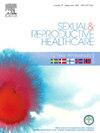“The Best of Both Worlds” a content analysis of midwives’ perspectives on using ultrasound for labour progress assessment
IF 1.7
3区 医学
Q3 PUBLIC, ENVIRONMENTAL & OCCUPATIONAL HEALTH
引用次数: 0
Abstract
Background
Midwives in labour wards at high-tech hospitals have witnessed significant technological advancements. Ultrasound devices for assessing labour progress may offer advantages over traditional vaginal examinations. However, it is important to examine the views of care providers before introducing this new technology.
Aim
The aim is to examine the views of midwives working in a hospital labour ward regarding the use of ultrasound devices in assessing the progress of labour and explore their views of implementing such a technology to improve care for women during labour.
Method
A qualitative study was conducted, using three semi structured focus groups interviews with 16 midwives from the hospital labour ward. A purposive sample was used to capture diverse backgrounds and experiences. Content analysis was used to identify key categories and subcategories.
Results
Two main categories emerged: 1) “Art of midwifery and technology,” including a debate between clinical skills and technology, midwives’ openness to learning, and their desire to control implementation; 2) “Women and babies come first,” highlighting the importance of options, safety, and the connection with the woman.
Conclusion
Midwives support evidence-based technological advancements that benefit clients without increasing unnecessary interventions. They believe ultrasound complements traditional vaginal exams and is a valuable option for certain groups of women. Midwives need to be involved in the implementation of new methods to ensure client well-being. Further research is needed to evaluate the benefits of using ultrasound for labour progress assessment.
“两全其美”内容分析助产士对使用超声波进行产程评估的观点
高科技医院产房的助产士见证了重大的技术进步。用于评估产程的超声设备可能比传统的阴道检查更有优势。然而,在引入这项新技术之前,检查护理提供者的观点是很重要的。目的调查医院产房助产士对使用超声波设备评估分娩进展的看法,并探讨她们对采用这种技术以改善产妇分娩护理的看法。方法采用三个半结构化的焦点小组访谈,对医院产房的16名助产士进行定性研究。一个有目的的样本被用来捕捉不同的背景和经历。内容分析用于确定关键类别和子类别。结果出现了两个主要类别:1)“助产艺术与技术”,包括临床技能与技术之间的辩论,助产士对学习的开放程度,以及他们控制实施的愿望;2)“女人和孩子是第一位的”,强调选择、安全以及与女人联系的重要性。结论助产士支持基于证据的技术进步,在不增加不必要干预的情况下使客户受益。他们认为超声波是传统阴道检查的补充,对某些女性群体来说是一个有价值的选择。助产士需要参与新方法的实施,以确保客户的福祉。需要进一步的研究来评估使用超声进行产程评估的好处。
本文章由计算机程序翻译,如有差异,请以英文原文为准。
求助全文
约1分钟内获得全文
求助全文
来源期刊

Sexual & Reproductive Healthcare
PUBLIC, ENVIRONMENTAL & OCCUPATIONAL HEALTH-
CiteScore
2.70
自引率
5.60%
发文量
73
审稿时长
45 days
 求助内容:
求助内容: 应助结果提醒方式:
应助结果提醒方式:


